Vagharshapat
Coordinates: 40°10′22″N 44°17′33″E / 40.17278°N 44.29250°E
| Vagharshapat Վաղարշապատ | |||
|---|---|---|---|
|
Mother See of Holy Etchmiadzin, from top left: Etchmiadzin Cathedral • Gate of Saint Gregory and the Altar • Gevorkian Seminary • Vatche and Tamar Manoukian Manuscript Library • Clock tower • Church of the Holy Archangels • Gate of King Trdat and Veharan Pontifical Residence | |||
| |||
| Nickname(s): Echmiadzin | |||
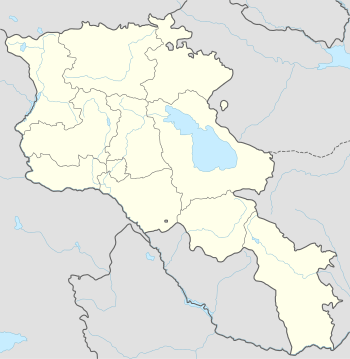 Vagharshapat | |||
| Coordinates: 40°10′22″N 44°17′33″E / 40.17278°N 44.29250°E | |||
| Country | Armenia | ||
| Marz (Province) | Armavir | ||
| Founded | 685 BC | ||
| Government | |||
| • Mayor | Karen Manvel Grigoryan | ||
| Area | |||
| • Total | 40 km2 (20 sq mi) | ||
| Elevation | 853 m (2,799 ft) | ||
| Population (2011 census) | |||
| • Total | 46,540 | ||
| • Density | 1,200/km2 (3,000/sq mi) | ||
| Time zone | (UTC+4) | ||
| Area code(s) | 0231 | ||
| Website | www.ejmiatsin.am | ||
| Sources: Population[1] | |||
Vagharshapat (Armenian: Վաղարշապատ pronounced [vɑʁɑɾʃɑˈpɑt]), commonly known as Ejmiatsin, is the fourth-largest city in Armenia and the most populous town in Armavir Province, located about 18 km (11 mi) west of the capital Yerevan, and 10 km (6 mi) north of the closed Turkish-Armenian border. Between 1945 and 1995,[2] the city was officially known as Ejmiatsin (also spelled Echmiadzin or Etchmiadzin, Էջմիածին, pronounced [ɛt͡ʃʰmjɑˈt͡sin]) which is still commonly used colloquially and in official bureaucracy.[3]
Vagharshapat is one of the historic capitals of Armenia and the main religious center of the Armenian people with the Etchmiadzin Cathedral, the most important Armenian Apostolic church, located in the city. It is thus unofficially known as a "holy city"[4][5] (սուրբ քաղաք).[6][7]
The 1989 census counted the population of the city as 61,000. The number has declined somewhat since, showing 58,388 in the 2001 census, and 46,540 in 2011.
Etymology
According to Movses Khorenatsi, the area of Vagharshapat was known as Artimed (Արտիմէդ), derived from the ancient Greek deity Artemis. Later, it was renamed Avan Vardgesi (Աւան Վարդգէսի, "Town of Vardges") or Vardgesavan (Վարդգէսաւան) by prince Vardges Manouk who rebuilt the settlement near the shores of Kasagh River, during the reign of king Orontes I Sakavakyats of Armenia (570–560 BC). However, in his first book Wars of Justinian, the Byzantine historian Procopius has cited to the city as Valashabad (Balashabad), named after king Valash (Balash) of Armenia. The name evolved into its later form by the shift in the medial L into a Gh, which is common in the Armenian language. Movses Khorenatsi mentioned that the Town of Vardges was entirely rebuilt and fenced by king Vagharsh I to become known as Noarakaghak (Նորաքաղաք, "New City") and later Vagharshapat.
History
Early history
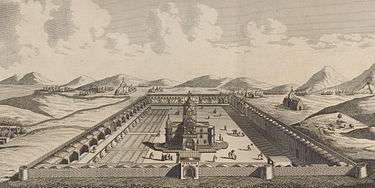
The territory of ancient Vagharshapat was inhabited since the 3rd millennium BC. Many sites, such as Metsamor Castle, Shresh hill and Mokhrablur hill date back to the neolithic period. The first written records about Vagharshapat were found in the inscriptions left by the Urartian king Rusa II (685–645 BC), where it was mentioned as Kuarlini (Կուարլինի). The inscription found in the archaeological site of ancient Vagharshapat cites to a water canal opened by king Rusa II, between Ildaruni river (Hrazdan River) and the valley of Kuarlini.
According to Movses Khorenatsi, the oldest name of Vagharshapat was Artimed (Արտիմէդ), derived from the ancient Greek deity Artemis. Later, it was renamed Avan Vardgesi (Աւան Վարդգէսի, "Town of Vardges") or Vardgesavan (Վարդգէսաւան) after being rebuilt by prince Vardges Manouk near the shores of Kasagh River, during the reign of king Orontes I Sakavakyats of Armenia (570–560 BC).
Under the reign of king Tigranes the Great (95-45 BC), the town was partly inhabited by Jewish captives.
In the first half of the 1st century AD, under the reign of the Armenian Arsacid king Vagharsh I of Armenia (117–144), the old town of Vardgesavan was renovated and renamed Vagharshapat (Վաղարշապատ). In his first book Wars of Justinian, the Byzantine historian Procopius has cited to the city as Valashabad (Balashabad), named after king Valash (Balash) of Armenia. The name evolved into its later form by the shift in the medial L into a Gh, which is common in the Armenian language. Movses Khorenatsi mentioned that the Town of Vardges was entirely rebuilt and fenced by king Vagharsh I to become known as Noarakaghak (Նորաքաղաք, "New City") and later Vagharshapat.

Vagharshapat has served as the capital of the Arsacid Kingdom of Armenia between 120 AD and 330 AD. After embracing Christianity as a state religion in Armenia in 301, Vagharshapat was gradually called Ejmiatsin (Armenian: Էջմիածին), after the name of the Mother Cathedral; the seat of the Armenian Catholicosate, which is considered as one of the oldest religious organizations in the world. As a spiritual centre of the entire Armenian nation, Vagharshapat has grown up rapidly and developed as an important centre of education and culture. The city was home to one of the oldest educational institutions in Armenia founded by Mesrop Mashtots.
The political capital of the Armenian kingdom was transferred to the city of Dvin in 336. Vagharshapat maintained its status as the country's most important city until the fall of the Arsacid Kingdom in 428. The city has gradually lost its importance under the Persian rule, specifically when the seat of the Catholicosate was transferred to Dvin in 452. However, the first manuscript library in Armenia was founded in 480 in Vagharshapat.
In 491, Catholicos Babken I of Armenia, along with the Albanian and Iberian bishops met in Vagharshapat and issued a condemnation of the Chalcedonian Definition.[8]
Foreign rule
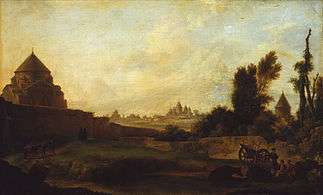
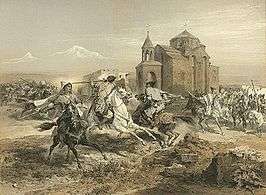
In 658 AD, Vagharshapat, along with the rest of the Ancient Armenian Highland, was conquered by the Arabs.
The city was briefly revived between the 9th and 11th centuries under the Bagratid Kingdom of Armenia, before being overrun by the Byzantines in 1045 and later by the Seljuqs in 1064. In the middle of the 13th century, Vagharshapat became part of the Ilkhanate of the Mongol Empire. After the invasion of Tamerlane in 1387, the city fell under the rule of the Timurid dynasty. During the last quarter of the 14th century the Ag Qoyunlu Sunni Oghuz Turkic tribe took over Armenia, including Vagharshapat. In 1400, Timur invaded Armenia and Georgia, and captured more than 60,000 of the survived local people as slaves. Many districts including Vagharshapat were depopulated.[9]
In 1410, Armenia fell under the control of the Kara Koyunlu Shia Oghuz Turkic tribe. Under the Turkic-Mongol rule, Vagharshapat was known to the Turks as Uchkilisa (Üçkilise, "three churches" in Turkic).
During the long period of the foreign rules started from 1045, Vagharshapat turned into an insignificant city until 1441, when the seat of the Armenian Catholicosate was transferred from the Cilician city of Sis back to Etchmiadzin.
Between 1502 and 1828, Armenia became part of the Persian state under the rule of Safaavid, Afsharid and Qajar dynasties, with short periods of Ottoman rule between 1578 and 1603 and later between 1722 and 1736.
In 1828, after the Russo-Persian War, Vagharshapat — as a part of the Erivan Khanate — was handed over to the Russian Empire as a result of the Treaty of Turkmenchay signed on 21 February 1828.
In their 1833 book Eli Smith and H. G. O. Dwight described Vagharshapat, then a village, as follows: "It presents nothing but a crowded collection of mud cabins, perhaps 500 in number."[10]
Soviet rule and independence
Armenia enjoyed a short period of independence between 1918 and 1920 before falling to the Bolshevik 11th Red Army and becoming part of the Soviet Union. In 1925, the new plan of rebuilding the modern town was introduced by architect Alexander Tamanian. It was finally completed between 1939 and 1943. In 1945, the town of Vagharshapat was officially renamed Etchmiadzin by the Soviet government.
During the 1950s and 1960s, the town has witnessed a massive wave of construction, including residential buildings and industrial plants. By the end of the 1960s, the historical monuments of the town; including the religious complex of the Mother See of Holy Etchmiadzin, Saint Hripsime Church, Saint Gayane Church and the surrounding area of Zvartnots Cathedral, were entirely rehabilitated.[11]
After the independence of Armenia, the town was officially renamed Vagharshapat in 1995. However, the town is still popularly known as Ejmiatsin.
Geography and climate

Vagharshapat is the largest satellite-city of Yerevan and the 4th largest in Armenia by population. It is located to the east of Yerevan in the basin of Kasagh River, in the northeastern extremity of Ararat plain. It is very close to the Zvartnots International Airport.
According to Moses of Chorene's History of Armenia and as a result of several archaeological researches conducted in the area, the most probable location of the ancient city of Vagharshapat is the area of Shresh Hill near Kasagh River.[12]
Shresh Hill or the Kond of Ghugo, as it was called by the local population, is only 500 metres (1,600 feet) away to the northeast of modern-day Vagharshapat, on the way to Oshakan. It is an artificial hill and has a diameter of 123 metres (404 feet) long. It was first excavated in 1870. In 1913 and 1928, the area was excavated by archaeologist Yervand Lalayan. Large-scale excavations were conducted around the hill and the nearby sites of Metsamor and Mokhrablur between 1945 and 1950.
Historically, Vagharshapat is at the heart of the Armenian Highland, in Aragatsotn canton (Armenian: Արագածոտն գաւառ Aragatsotn gavar, not to be confused with the current Aragatsotn Province) of Ayrarat province, within Armenia Major.
The city has an average elevation of 853 metres (2,799 feet) above sea level with a dry continental climate.
| Climate data for Vagharshapat | |||||||||||||
|---|---|---|---|---|---|---|---|---|---|---|---|---|---|
| Month | Jan | Feb | Mar | Apr | May | Jun | Jul | Aug | Sep | Oct | Nov | Dec | Year |
| Average high °F (°C) | 34.9 (1.6) |
39.9 (4.4) |
52.9 (11.6) |
66.2 (19) |
75.9 (24.4) |
83.8 (28.8) |
91.6 (33.1) |
90.5 (32.5) |
83.1 (28.4) |
68.9 (20.5) |
54.3 (12.4) |
40.8 (4.9) |
65.23 (18.47) |
| Average low °F (°C) | 18.9 (−7.3) |
22.5 (−5.3) |
32.4 (0.2) |
43.0 (6.1) |
50.9 (10.5) |
57.4 (14.1) |
64.0 (17.8) |
63.5 (17.5) |
54.3 (12.4) |
43.7 (6.5) |
34.2 (1.2) |
25.5 (−3.6) |
42.53 (5.84) |
| Average precipitation inches (mm) | 0.79 (20.1) |
0.87 (22.1) |
1.06 (26.9) |
1.42 (36.1) |
2.01 (51.1) |
1.14 (29) |
0.63 (16) |
0.47 (11.9) |
0.55 (14) |
1.14 (29) |
0.98 (24.9) |
0.79 (20.1) |
11.85 (301.2) |
| Source: http://en.climate-data.org/location/15442/ | |||||||||||||
Demographics
Population

Vagharshapat is the largest urban community of Armavir Province. However, the population of the town has gradually declined since the collapse of the Soviet Union.
Here is a population timeline of Vagharshapat since 1830:
| Date | Population | Note(s) |
|---|---|---|
| 1830[13] | 2,175 | the fourth largest in the Armenian Oblast |
| 1892[14] | 3,000 | overwhelmingly populated by Armenians |
| 1897[15] | 5,267 | 94.8% Armenians |
| 1914[16] | 5,755 | |
| 1926[17] | 8,436 | 99.1% Armenians |
| 1959[16] | 19,560 | |
| 1968[16] | 27,100 | |
| 1976[18] | 42,000 | |
| 1990[16] | 60,000 | |
| 2001[19] | 51,280 | de facto population |
| 2011[19] | 46,540 | de facto population |
Religion


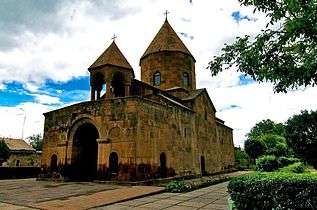
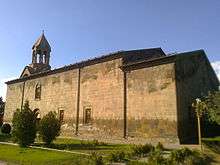
The majority of the Vagharshapat population are ethnic Armenians who belong to the Armenian Apostolic Church. The regulating body of the church is the Diocese of Armavir, headed by Bishop Sion Adamyan. The (Holy Mother of God Cathedral of Vagharshapat is the seat of the diocese.
The religious complex of the Mother See of Holy Etchmiadzin (Armenian: Մայր Աթոռ Սուրբ Էջմիածին) is the spiritual and administrative headquarters of the worldwide Armenian Apostolic Church and the Pontifical Residence of the Supreme Patriarch and Catholicos of All Armenians. The Mother Cathedral is found in the complex surrounded with many structures built throughout the centuries. Most buildings are of great architectural significance, such as the old and new Pontifical Residences, the Chancellery or the Divanatoon, the Gate of King Trdat, Alex and Marie Manoogian Treasury Museum (1982), Khrimian Museum, Yeremian Monastic cells, the old Seminary building, the Clock Tower, the Bookstore, etc. The Gevorkian Seminary is a theological college of the Armenian Apostolic Church founded by Catholicos Gevork IV in 1874 within the complex of the Mother See. Apart from the Mother Cathedral, Vagharshapat is home to many other important Armenian churches and cathedrals. The Cathedral of Etchmiadzin, the Churches of Saint Hripsimé, Saint Gayane and Saint Shoghakat, and the archaeological site of Zvartnots are listed among the UNESCO World Heritage Sites.
Churches
- Etchmiadzin Cathedral: historically, the focal point of the town is the Mother Cathedral of Holy Etchmiadzin, (Armenian: Մայր Տաճար Սուրբ Էջմիածին Mayr Tachar Surp Ejmiatsin) which is one of the oldest churches in the world. Originally known as the Holy Mother of God Church (Armenian: Սուրբ Աստուածածին Եկեղեցի Surp Astvatsatsin Yekeghetsi), it was first built by Saint Gregory the Illuminator as a vaulted basilica in 301–303, when Armenia had just adopted Christianity as a state religion (the first such in world history). The church was enlarged in many occasions, notably in 480, 618 and 1658.
- Saint Hripsime Church: built in 618, the Church of Saint Hripsimé has basically survived almost unchanged. It is considered one of the oldest surviving churches in Armenia, known for its fine architecture of the classical period, which influenced many other Armenian churches. It was erected in 618 by Catholicos Gomidas atop the original mausoleum, built by Catholicos Sahak the Great in 395, which contained the remains of the martyred Saint Hripsimé. According to the 17th century Armenian historian Arakel of Tabriz, the church was renovated during 1651–1653 by Catholicos Philip I. Repairs were made on the roof, top of the dome, the walls and bases. A cross was placed on top of the roof, and a small portico was added to the western side. It is one of the few churches in Armenian that remained active during the Soviet period.
- Saint Gayane Church: built in 630 by Catholicos Ezra I, Saint Gayane Church is distinguished by its harmonious proportions. It is a three-nave domed basilica with an octagonal drum resting on four internal pillars that divide the interior of the church into three. Its design remained unchanged despite partial renovations of the dome and some ceilings in 1652.
- Zvartnots Cathedral: Zvartnots is a 7th-century ruined circular Armenian cathedral built by the order of Catholicos Nerses III the Builder between 641 and 653. It is at the eastern edge of modern-day Vagharshapat. Zvartnots was a majestic cathedral famous for its unique design, dedicated to Saint George, built at the place where a meeting between king Tiridates III and Saint Gregory the Illuminator was supposed to have taken place. In 930, the church was ruined by an earthquake and remained buried until it was rediscovered in the early 20th century by architect Toros Toramanian. The site was excavated between 1900 and 1907, uncovering the foundations of the cathedral as well as the remains of the Pontifical palace and a winery.
- Shoghakat Church: meaning 'the drop of light', Shoghakat Church is a single-nave domed basilica, built and completed in 1694 by prince Aghamal Sorotetsi during the period of Catholicos Nahabed I. It is built with red and black tufa stones, erected on the remains of a 6th-century basilica. The remains of a 4th-century small chapel could be seen at the southwestern end of Saint Shoghakat Church.[20]
- Holy Mother of God Cathedral of Vagharshapat: was built in 1767, during the period of Catholicos Simeon I. It is located north of the Mother See of Holy Etchmiadzin, at the centre of modern-day Vagharshapat. It was built on the remains of a 16th-century wooden church. The churchyard was home to a religious school. During the Soviet period, the church remained active and witnessed a major renovation in 1986 through the efforts of Catholicos Vazgen I.[21] Currently, the Holy Mother of God Cathedral is the seat of the Armavir Diocese of the Armenian Apostolic Church.
- Saints Vartan and Hovhannes Baptistery, a chapel located north of the Mother Cathedral and designated for baptism ceremonies. The three-domed chapel was designed by architects Jim Torosyan and Romeo Julhakyan. The chapel was consecrated on 26 September 2008 and the construction was funded by the British-Armenian philanthropist Armen Sarkissian.
- Church of the Holy Archangels: built between 2009 and 2011 and located in the yard of Gevorkian Seminary building. The single-domed church was consecrated on 5 November 2011. It was designed by architect Jim Torosyan. The construction work was funded by the Armenian philanthropist Gagik Galstyan.
Culture
Vagharshapat is the cultural centre of Armavir and one of the important centres of the entire republic. The Komitas Palace of Culture is operating in the town since 1957, while the Ejmiatsin National Gallery is operating since 1970.
The town is also home to a number of museums including the Vagharshapat Ethnographic Museum, Khoren Ter-Harutyunyan Museum and Gallery, Mher Abeghian Museum and Gallery, and Hovhannes Hovhannisyan House-museum. However the most prominent museums of Vagharshapat are located within the Mother See complex, including:
- Etchmiadzin Cathedral Museum opened in 1869 by Catholicos George IV,
- The Catholicosal Museum within the old pontifical residence or Hin Veharan built in 1738–1741 and serves as Catholicosal Museum since 1968.[22]
- Khrimian Museum: built and opened in 1896 by Catholicos Mkrtich I of Van. It was recently renovated to become a museum of art.[23]
- Alex and Marie Manoogian Treasury House: opened on 11 October 1982, designed by architect Baghdasar Arzoumanian. The museum is home to treasures of the Armenian Church throughout the history.
- Ruben Sevak Museum: opened in 2013 within the Ghazarapat building of the Mother See.
The Mother See is also home to the Pontifical Bookstore operating since 1962, and the *Vatche and Tamar Manoukian Manuscript Depository opened in 2012.[24][25][26]
The town celebrates the "Ejmiatsin Day" annually since 2008 in Vagharshapat on the 8th of October. According to the old Armenian tradition, Mesrop Mashtots brought the newly created Armenian alphabet to Vagharshapat on 8 October 405.[27]
Transportation
Vagharshapat is connected with Yerevan and southern Armenia through the M-5 Motorway, while the M-3 Motorway connects the town with northern Armenia.
The Zvartnots International Airport of Yerevan is located only 10 kilometres (6 miles) east of Vagharshapat.
Economy
Industry
Vagharshapat was home to the 1st paper factory in the history of Armenia. In 1780, Catholicos Simeon I of Yerevan founded the Etchmiadzin Paper Factory which served for 6 years.
Under the Soviet rule, Ejmiadzin became an important industrial centre. It was home to 4 major industrial firms specialized in the production of military technology. However, the productivity of the plants declined after the fall of the Soviet Union.
Currently, the industry of the town is mainly based on food-processing. The largest industrial firms of the town are the "Echmiadzin Instrument Making Factory" founded in 1966, the "E.P.G. Echmiadzin Cannery" founded in 1969, the "Echmiadzin Kat" dairy factory founded in 1997, the "Sonimol" plant for grains founded in 2001, the "SarKop" wine brandy and vodka factory founded in 2005, and the "Ekologia V.K.H." biological waste destruction plant founded in 2009.[28]
Tourism
Being the worldwide spiritual centre of the Armenian nation, Vagharshapat is a major tourist destination for Armenians as well as foreign visitors. It is home to the UNESCO World Heritage Sites of Etchmiadzin Cathedral, Zvartnots Cathedral, Saint Hripsime Church, Saint Gayane Church and Shoghakat Church, grouped overall as the Cathedral and Churches of Echmiatsin and the Archaeological Site of Zvartnots.
Education
Gevorkian Theological Seminary is one of the most significant educational institutions of the Republic of Armenia. Other educational institutions include the Grigor Lusavorich University and the intermediate college of vocational education.
The Karekin I Centre of Theology and Armenology is also functioning in the town since 2000.
As of 2009, Vagharshapat is home to 14 public education schools, 8 kindergartens and 2 musical academies.[29]
The new complex of Eduardo Eurnekian High School of the Mother See is currently under construction.
Sport
FC Vagharshapat, the town's only football club, made its debut in the Armenian Premier League as Zvartnots Echmiadzin in 1992. The club was dissolved in early 2006 and is currently inactive from professional football. The Vagharshapat City Stadium located immediately to the south of the Mother See complex, is able to hold up to 3,000 spectators.
In February 2016, it was announced that the Football Federation of Armenia will launch the construction of a football academy at the southern suburb of the town, on the Vagharshapat-Margara motorway. The project will occupy an area of 55,601 square metres (598,484 square feet) and is expected to be completed by 2020.[30]
International relations
Vagharshapat (Etchmiadzin) has been a member of the Organization of World Heritage Cities (OWHC)[31] since 2007.[32]
Twin towns — sister cities
Vagharshapat-Ejmiatsin has six sister cities:[33]
|
|
Famous natives
- Zacharias II (?-1520), Catholicos of All Armenians 1515–1520.
- Gregory XII (1498–1590), Catholicos of All Armenians 1576–1590.
- David IV (?-1633), Catholicos of All Armenians 1590–1629.
- Makar Yekmalyan (1856–1905), composer.
- Abraham Gyulkhandanyan (1875-1946), politician and historian.
- Levon Manaseryan (1925), painter.
- Aram Asatryan (1953), singer.
- Khoren Gevor (1980), professional boxer.
See also
References
- ↑ "Armstats:Population" (PDF). Retrieved 2013-01-31.
- ↑ "Պատմաաշխարհագրական ակնարկ [Historical-geographic overview]" (in Armenian). Armavir Province: Armenian Ministry of Territorial Administration.
...Վաղարշապատ (1945-1995թթ. կոչվել է Էջմիածին) քաղաքը...
- ↑ "Էջմիածի՞ն, թե՞ Վաղարշապատ". Aravot (in Armenian). 26 October 2010.
- ↑ Ring, Trudy; Watson, Noelle; Schellinger, Paul, eds. (1994). International Dictionary of Historic Places: Middle East and Africa, Volume 4. Taylor & Francis. p. 250.
The holy city of Echmiadzin, where the Christian church in Armenia first began...
- ↑ Stransky, Thomas F.; Sheerin, John B. (1982). Doing the Truth in Charity: Statements of Pope Paul VI, Popes John Paul I, John Paul II, and the Secretariat for Promoting Christian Unity, 1964-1980. Paulist Press. p. 230.
...from the holy city of Etchmiadzin...
- ↑ "Ամառը Հայաստանում անցկացնելու 10 հետաքրքիր տարբերակ" (in Armenian). Armenpress. 2 June 2015.
- ↑ "Էջմիածինը 2695 տարեկան է" (in Armenian). A1plus. 8 October 2010.
- ↑ Zvartnots and the Origins of Christian Architecture in Armenia, W. Eugene Kleinbauer, The Art Bulletin, Vol. 54, No. 3 (Sep., 1972): 261.
- ↑ "The Turco-Mongol Invasions". Rbedrosian.com. Retrieved 2012-05-22.
- ↑ Smith, Eli; Dwight, H. G. O. (1833). Researches of the Rev. E. Smith and Rev. H.G.O. Dwight in Armenia: Including a Journey Through Asia Minor, and Into Georgia and Persia, with a Visit to the Nestorian and Chaldean Christians of Oormiah and Salmas, Volume 2. Crocker and Brewster. p. 93.
- ↑ History of Ejmiatsin
- ↑ Ejmiatsin: History
- ↑ Hakobyan, Tatul (10 December 2015). "Հայկական մարզի (1828-1840թթ.) 1000-ից ավելի բնակիչ ունեցող 10 բնակավայրերը" (in Armenian). ANI Foundation for Armenian Studies.
- ↑ "Вагаршапат". Brockhaus and Efron Encyclopedic Dictionary Volume I (in Russian). 1892. p. 336.
- ↑ http://demoscope.ru/weekly/ssp/emp_lan_97_uezd.php?reg=589
- 1 2 3 4 "Հայաստանի Հանրապետության բնակավայրերի բառարան" (PDF). Armenian State Cadaste. 2008. p. 186.
- ↑ http://ethno-kavkaz.narod.ru/echmiadzin26.html
- ↑ "Էջմիածին [Ejmiatsin]". Soviet Armenian Encyclopedia Volume 5 (in Armenian). 1978. p. 64.
- 1 2 http://armstat.am/file/doc/130.pdf
- ↑ Yeghishe.am: Shoghakat
- ↑ Holy Mother of God Church in Vagharshapat
- ↑ Old pontifical residence
- ↑ Khrimian Museum
- ↑ Vatche and Tamar Manoukian Manuscript Depository
- ↑ Bookstore
- ↑ Printing house
- ↑ "Hetq online: Etchmiadzin Day Celebrated Today". Hetq.am. Retrieved 2013-01-31.
- ↑ Ekologia V.K.H. biological waste destruction plant opened in Echmiadzin
- ↑ "Union of Communities of Armenia: Ejmiatsin". Caa.am. Retrieved 2013-01-31.
- ↑ Football development in Armavir Province
- ↑ "Echmiatsin, Arménie" (in French). OVPM. Retrieved 2013-01-31.
- ↑ Etchmiadzin: International relations(Russian)
- ↑ Sister cities
External links
| Wikimedia Commons has media related to Vagharshapat. |
- Armenia Photos: The Holy City of Etchmiadzin by East-Site.com
- Etchmiadzin Old Photos by ChurchInArmenia.com
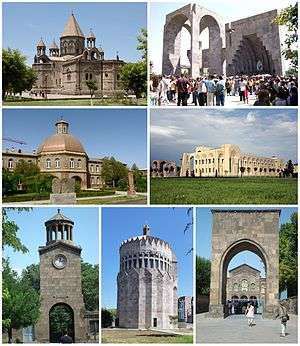

.jpg)

